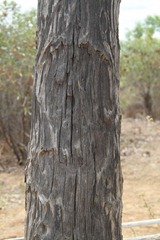 From Croydon we drove, still on the Gulf Developmental Road, through to Georgetown.
From Croydon we drove, still on the Gulf Developmental Road, through to Georgetown.
 We stopped for lunch at Cumberland Chimney and Dam, the last relic of a gold crushing plant and then followed the alternate Savannah Way through Forsayth and Einasleigh.
We stopped for lunch at Cumberland Chimney and Dam, the last relic of a gold crushing plant and then followed the alternate Savannah Way through Forsayth and Einasleigh.
Forsayth was the last stop of the Savannahlander train, which now runs as a tourist train. This railway was supposed to go to Chillagoe for the copper mine, however the mine closed before the train arrived . 
When the mine closed the train serviced the locals bringing goods in and cattle down to the coast once a week. Cattle now travel by road train, hence the other name for the road “the beef road”.
Cattle are pastured all along the road, much of it unfenced. Australian beef is good for you because it is generally very free range and consequently fit and healthy. Natural selection probably means the ones that aren't don't survive, although this one managed to get out of the way of our Landcruiser. 


 We camped at Mt. Surprise, so named because they were surprised to find water here, so Mt. Surprise came as a pleasant surprise.
We camped at Mt. Surprise, so named because they were surprised to find water here, so Mt. Surprise came as a pleasant surprise.
This is a typical small country town and a stop on the Savannahlander train. Mt. Surprise has an undercarriage wash so that the car and caravan don't take weeds East or West. For medical care Mt. Surprise has a nurse in attendance twice a week, for all other problems ring the Flying Doctor or visit the “Thirst Aid Station” at the local hotel.
From Mt. Surprise we drove to Undara. This is a nice relaxing place to refresh. The reception, restaurant and many of the motel style units are old railway carriages.
 When the Collins’ family were starting their resort they saw a pile of railway carriages by the side of the road, with a sign giving a telephone number to call if one saw someone defacing them. Mr Collins rang to ask what was planned for the carriages and was told they were to be burnt the next day.
When the Collins’ family were starting their resort they saw a pile of railway carriages by the side of the road, with a sign giving a telephone number to call if one saw someone defacing them. Mr Collins rang to ask what was planned for the carriages and was told they were to be burnt the next day.
 Mr Collins bought and restored them before locating them at the Undara resort. The sleepers carriages are set along the old Cobb and Co Coach Road, attractive additions to the resort.
Mr Collins bought and restored them before locating them at the Undara resort. The sleepers carriages are set along the old Cobb and Co Coach Road, attractive additions to the resort.
The resort is a nice place to end a long trip as it is comfortable and restful. We had dinner there. The beef served is Collins beef from the property and it is excellent. They also offer a bush breakfast, which reminded us of the big Christmas Camps we used to have.
The reason for this resort/ National Park is the Undara Lava Tubes. These were created 190,000 years ago in the McBride Volcanic Province.
 There once was a high level of volcanic activity in this area due to the rubbing tog
There once was a high level of volcanic activity in this area due to the rubbing tog ether of two tectonic plates.
ether of two tectonic plates.
Sometimes there were classic eruptions but elsewhere, as at Undara, just lava flowed.
When the lava flowed into watercourses or gullies the outside solidified but the inside remained molten and kept flowing until the lava had all gone. The result is rather like a large garden hose where the outside is rock and you can walk through the centre. You can only go into them with a guide as there are toxic gasses in some and sometimes the roofs, walls or floors are unstable.
 Different vegetation grows where the roof has fallen in and you can follow the lava tubes through the country side by the darker green band of vegetation. We walked through the lava tubes with a guide and had afternoon tea at the old Homestead.
Different vegetation grows where the roof has fallen in and you can follow the lava tubes through the country side by the darker green band of vegetation. We walked through the lava tubes with a guide and had afternoon tea at the old Homestead.
In the morning we walked around the rim of Kalkani Crater with sweeping views across the lava plain.

















 Before air conditioning the best way of keeping cool was to not have the sun touch the sides of the house and have air moving all the time. This is the reason for the wide verandahs as they protected the walls from the sun and the occupants could sit on them and catch the breeze. In the centre of Australia the nights are cold so the house cools quickly and you can sleep.
Before air conditioning the best way of keeping cool was to not have the sun touch the sides of the house and have air moving all the time. This is the reason for the wide verandahs as they protected the walls from the sun and the occupants could sit on them and catch the breeze. In the centre of Australia the nights are cold so the house cools quickly and you can sleep. 



























![NEW - THE MAPS [By Popular Request]](http://1.bp.blogspot.com/-Vajyd8kXoSk/TtvtX94QV7I/AAAAAAAAEBk/0MJEoH3UojI/s187/Around%2BAustralia.jpg)